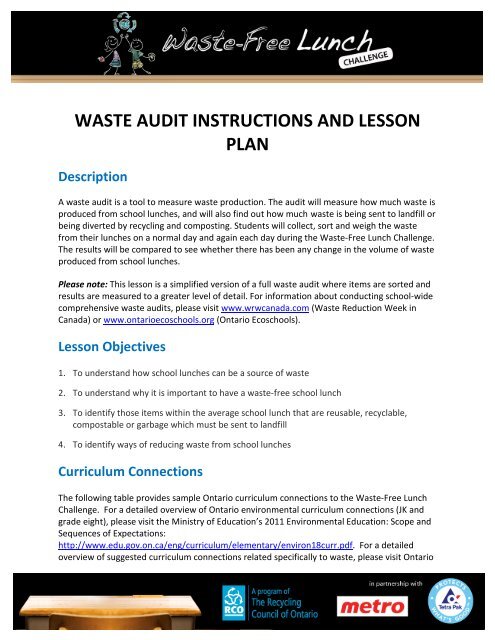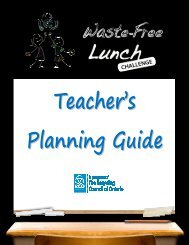waste audit instructions and lesson plan - Waste-Free Lunch ...
waste audit instructions and lesson plan - Waste-Free Lunch ...
waste audit instructions and lesson plan - Waste-Free Lunch ...
Create successful ePaper yourself
Turn your PDF publications into a flip-book with our unique Google optimized e-Paper software.
2. Do not put reusable lunch boxes or containers into the bag with the lunch <strong>waste</strong>. If youwould like to provide a visual reusable container demonstration, label each student’s lunchbag <strong>and</strong> containers with the student’s name <strong>and</strong> classroom. Select a separate area (e.g.table) for reusable items such as lunch boxes. For health <strong>and</strong> safety purposes, this must beseparate from the <strong>waste</strong>. Collect the reusable containers <strong>and</strong> observe the differencebetween the reusable containers <strong>and</strong> the <strong>waste</strong>.3. After lunch, each class will bring their bag of lunch <strong>waste</strong> material to a designated locationwhere the school lunch <strong>audit</strong> will occur.4. Spread the tarp or plastic sheet out in a suitable space – well ventilated <strong>and</strong> room forstudents to move around the sorting sheet.5. Use labels/signs to create separate sections for items on the tarp/plastic sheet. Make surespace is left for the unsorted <strong>waste</strong>. Briefly explain the meanings of the different categories.6. Tip each classroom’s lunch <strong>waste</strong> bag or container onto the sheet.7. Select students to sort items (using gloves <strong>and</strong> tongs) into categories according to their finaldestination (l<strong>and</strong>fill/garbage, recyclable or compostable).Note: If there is no recycling program, organics collection or in-school compost system, itmay be useful to use the ‘compostable’ category as a way of identifying a future classroomor school project to manage food scraps. Classrooms that do not currently have a recyclingor organic collection service should simply complete the <strong>audit</strong> exercise <strong>and</strong> record results asif there are recycling <strong>and</strong> organic <strong>waste</strong> collections available. This will enable the entry to bejudged fairly with others.8. Select students to place each pile in a pre-weighed bag or container <strong>and</strong> weight it. Subtractthe weight of the container. Record all information on the <strong>Waste</strong> Audit Worksheetincluding: weight of <strong>waste</strong> generated, weight of recyclables, weight of compostable material<strong>and</strong> number of student lunches.After the <strong>Waste</strong> Audit1. Select students to collect items in each category <strong>and</strong> dispose of <strong>waste</strong>, recycling, etc asappropriate. Ensure that all reusable items (lunch boxes, lunch bags) are returned to theirowners.2. Clean containers <strong>and</strong>/tarp as appropriate <strong>and</strong> return to storage.3. Make sure all students wash their h<strong>and</strong>s thoroughly before returning to class.
Analyzing the resultsAs part of the competition, complete the <strong>waste</strong> <strong>audit</strong> on a normal day <strong>and</strong> then each day duringthe week-long Challenge. To analyze results:1. Download the <strong>Waste</strong> Audit Worksheet Tool from the Teachers Resources page of the WFLCwebsite.2. Copy your results into the appropriate sheets <strong>and</strong> view final results in the sheet entitledFinal Results for Entry Form. This table will show the difference between the <strong>waste</strong>produced on a normal day <strong>and</strong> the daily average produced during the <strong>Waste</strong>-<strong>Free</strong> <strong>Lunch</strong>Challenge (as a total <strong>and</strong> per student). Alternatively, have the students complete thecalculations <strong>and</strong> compare the results.3. The Recycling Council of Ontario will begin accepting final submissions on October 21 st . Onthe <strong>Waste</strong>-<strong>Free</strong> <strong>Lunch</strong> Challenge website homepage, click on the SUBMIT YOUR RESULTSbutton. Transcribe your results <strong>and</strong> answer all of the questions. The final submissionquestions can be found in Attachment 4. Please note that any responses over the wordcount will be cut off <strong>and</strong> any additional text will not be sent to the RCO for assessment.AssessmentThe following suggestions are provided for discussion <strong>and</strong> for assessing students’ knowledge<strong>and</strong> underst<strong>and</strong>ing of <strong>waste</strong> management issues.Primary (JK-3):• Where does the <strong>waste</strong> in each category (garbage, recycling, <strong>and</strong> organics) go once you put itin the bin?• How does it make you feel when you look at a <strong>waste</strong>-free lunch <strong>and</strong> a lunch that produceslots of garbage?• What should/should not be in a <strong>waste</strong>-free lunch?Junior (4-6):• How much <strong>waste</strong> do you think you produce each year just from your school lunches?
Useful WebsitesMinistry of Education- Environmental EducationThis is an extremely helpful resource created by the Ministry of Education. It outlines in detailhow to connect environmental topics to all areas of the curriculum between JK-8. The providedlink is the 2011 Edition.http://www.edu.gov.on.ca/eng/curriculum/elementary/environ18curr.pdfOntario EcoSchools – <strong>Waste</strong> Minimization by Grade (1-8)This resource is organized around “big ideas” that identify clusters of learning expectations inScience <strong>and</strong> Technology, Social Studies, <strong>and</strong> Geography linked to <strong>Waste</strong> Minimization. Archivedinternet resources offer background facts <strong>and</strong> student learning activities.http://www.ontarioecoschools.org/curriculum_resources/<strong>waste</strong>_ele.html<strong>Waste</strong> Reduction Week - Resources for SchoolsIncludes a slide show <strong>and</strong> homework assignment.http://www.wrwcanada.com/index.php?option=com_content&view=article&id=16&Itemid=19&lang=enEnviro Schools - Measuring Change (New Zeal<strong>and</strong>)Zero <strong>Waste</strong> Annual Summary Sheet, Zero <strong>Waste</strong> Data Collection Sheets, Zero <strong>Waste</strong> TeacherSupport Activitieshttp://www.measuringchange.org.nz/resources/zero-<strong>waste</strong>
ATTACHMENT 1. <strong>Waste</strong> Audit Worksheet – Normal Day (Pre-Challenge)Please note that these worksheets are excerpts from the <strong>Waste</strong> Audit Tool (Excel file)WASTE AUDIT WORKSHEET - NORMAL DAY (PRE-CHALLENGE)School or Classroom:Number of student lunches:1 lb = 0.45359237 kg1 kg = 2.20462262 lbsInsert your measurements according to the destination of the lunch <strong>waste</strong>. See example below.MaterialWeight (kg)*A. Garbage - items that are not recyclable or compostable <strong>and</strong> will haveto be sent to l<strong>and</strong>fillB. Recyclable - items that can be recycled (e.g. municipal or privatecontract recycling collection)C. Organics - items that can be composted (e.g. municipal organic <strong>waste</strong>collection or in-school composting /worm farm program)* Remember to consider the weight of the container in your resultsTotalExample Only - Results are not typicalSchool or Classroom: Mrs Smith, Grade 4Number of student lunches: 23MaterialA. Garbage - items that are not recyclable or compostable <strong>and</strong> will haveto be sent to l<strong>and</strong>fillB. Recyclable - items that can be recycled (e.g. municipal or privatecontract recycling collection)Weight (kg)*C. Organics - items that can be composted (e.g. municipal organic <strong>waste</strong>collection or in-school composting /worm farm program)2.6Total 10.24.23.4
ATTACHMENT 2. <strong>Waste</strong> Audit Worksheet – During the ChallengePlease note that this worksheet is an excerpt from the <strong>Waste</strong> Audit Tool (Excel file)WASTE AUDIT WORKSHEET - DURING THE CHALLENGESchool or Classroom: 1 lb = 0.45359237 kg 1 kg = 2.20462262 lbsInsert your results each day during the week according to the destination of the lunch <strong>waste</strong>.Material Monday Tuesday Wednesday Thursday FridayA. Garbage - items that are not recyclable orcompostable <strong>and</strong> will have to be sent tol<strong>and</strong>fillB. Recyclables - items that can be recycled (e.g.municipal or private contract recyclingcollection)C. Organics - items that can be composted (e.g.municipal organic <strong>waste</strong> collection or inschoolcomposting /worm farm program)Weight (kg)* Daily AverageWeekTotal(= Week Total/5days)D. Number of Student <strong>Lunch</strong>es* Remember to consider the weight of the container in your results
ATTACHMENT 3. Final Results for your Entry FormPlease note that this worksheet is an excerpt from the <strong>Waste</strong> Audit Tool (Excel file)RESULTS FOR YOUR ENTRY FORMSchool or Classroom:Insert your collated results from both worksheets in the coloured cells below <strong>and</strong> complete the calculations. Please notethat the Excel version of this table (in the <strong>Waste</strong> Audit Tool) will complete the calculations for you.Copy these results into Section 2 of your Entry FormA Garbage (kg) - items that cannot be recycled orcompostedNormal Day(before)Daily Average duringWFLC(weekly total/ 5 days)Change in <strong>waste</strong>producedB Recyclable material collected (kg) - items whichcan be recycledC Organic food <strong>waste</strong> collected (kg) - items whichcan be compostedD Total number of students lunches - students inthe registered classroom or school onlyWeight of garbage to l<strong>and</strong>fill per student (kg) =(A) divided by (D)
ATTACHMENT 4. Final Entry FormSECTION 1. CLASSROOM OR SCHOOL REGISTRATIONThis information will help us to keep track of your entry <strong>and</strong> to confirm that your classroom orschool participated in the <strong>Waste</strong>-<strong>Free</strong> <strong>Lunch</strong> Challenge during <strong>Waste</strong> Reduction Week.District School Board (If applicable) ___________School Name ___________Name of registered Classroom Teacher/Principal ___________Email address of registered Classroom Teacher/Principal ___________Participating classroom(s)/grade(s) ___________Number of participating students ___________Dates of your <strong>Waste</strong>-<strong>Free</strong> <strong>Lunch</strong> Challenge ___________Which category are you nominating for? Beginner__ Advanced (established low/<strong>waste</strong>-freeprograms) __Has your school Principal given permission for your entry to be reproduced by the RecyclingCouncil of Ontario?Yes ____Name of Principal ____Please note: Final entry may be used by the Recycling Council of Ontario to develop casestudies for future years. You may be contacted by the RCO for further information about youractivities.SECTION 2. WASTE AUDIT RESULTSPlease complete section two to report your collated lunch <strong>waste</strong> <strong>audit</strong> results on a normal day<strong>and</strong> during the <strong>Waste</strong>-<strong>Free</strong> <strong>Lunch</strong> Challenge. Please provide measurements in metric kilogramsonly. These results will be used to judge your classroom performance in the Challenge.Normal Day (before)(A) Garbage (kg) - items that cannot be recycled or composted ___________kg(B) Recyclable material collected (kg) - items which can be recycled ___________kg(C) Organic food <strong>waste</strong> collected (kg) - items which can be composted ___________kg(D) Total number of students lunches - students in the registered classroom/school only___________
Weight of garbage to l<strong>and</strong>fill per student (kg) = (A) divided by (D) ___________Daily Average during WFLC (weekly total/number of days)(A) Garbage (kg) - items that cannot be recycled or composted ___________ kg(B) Recyclable material collected (kg) - items which can be recycled ___________ kg(C) Organic food <strong>waste</strong> collected (kg) - items which can be composted ___________ kg(D) Total number of students lunches students in the registered classroom/school only___________Weight of garbage to l<strong>and</strong>fill per student (kg) = (A) divided by (D) ___________ kgChange in <strong>waste</strong> produced(A) Garbage (kg) - items that cannot be recycled or composted ___________ kg(B) Recyclable material collected (kg) - items which can be recycled ___________ kg(C) Organic food <strong>waste</strong> collected (kg) - items which can be composted ___________ kgWeight of garbage to l<strong>and</strong>fill per student (kg) = (A) divided by (D) ___________SECTION 3. CLASSROOM/SCHOOL REPORTPlease describe below, in 100 words or less (per question) how your registered class or schoolparticipated in the <strong>Waste</strong>-<strong>Free</strong> <strong>Lunch</strong> Challenge. Answers should address the followingquestions <strong>and</strong> may be answered by students where appropriate.1. Why did your class/school choose to participate in the <strong>Waste</strong>-<strong>Free</strong> <strong>Lunch</strong> Challenge? (Max.100 words)__________________________________________________________________________________________________________________________________________________________________________________________________________________________________________2. How did you promote the <strong>Waste</strong>-<strong>Free</strong> <strong>Lunch</strong> Challenge in your classroom/school?(e.g. posters, letters home to parents, announcements) (Max. 100 words)__________________________________________________________________________________________________________________________________________________________________________________________________________________________________________3. How will your class/school continue to reduce <strong>waste</strong> from school lunches?
(e.g. a <strong>waste</strong>-free lunch policy or regular <strong>waste</strong>-free lunch days throughout the year) (Max. 100words)__________________________________________________________________________________________________________________________________________________________________________________________________________________________________________4. How did your classroom/school respond to the Challenge? (i.e. what did you learn? Studenttestimonials encouraged) (Max. 100 words)__________________________________________________________________________________________________________________________________________________________________________________________________________________________________________5. Advanced Category only- If your school lunches are already low <strong>waste</strong> or <strong>waste</strong>-free, pleasetell us how you promote <strong>waste</strong> reduction in other areas of the school or community (e.g. <strong>waste</strong>reduction activities as part of an EcoAction Plan) (Max. 100 words)__________________________________________________________________________________________________________________________________________________________________________________________________________________________________________SECTION 4. FEEDBACKYour feedback is a valuable source of ideas <strong>and</strong> suggestions to improve future <strong>waste</strong>-free lunchevents. Please select all options that apply to you.1. Which of the resources provided on the <strong>Waste</strong>-<strong>Free</strong> <strong>Lunch</strong> Challenge website did you finduseful?___ Teacher Resource List:___ WFLC Summary Video___ Getting Started - Teacher's Planning Guide___ Planning Your Event Task List___ <strong>Waste</strong> Audit Instructions <strong>and</strong> Lesson Plan___ Useful Web links___ <strong>Waste</strong> Audit Instructional Video___ <strong>Waste</strong>-<strong>Free</strong> <strong>Lunch</strong> Challenge Poster___ Sample Letter to Parents___ Sample Announcements___ <strong>Waste</strong> Reduction <strong>and</strong> Recycling Facts___ Sample School Newsletter___ <strong>Waste</strong>-<strong>Free</strong> <strong>Lunch</strong> Challenge Sample Web Banner___ Sample School Media Release
___ <strong>Waste</strong> Audit Tool (EXCEL)___ Weight of Common <strong>Lunch</strong> Items___ Sample Student Certificate___ Fridge Reminder Resource (Parent Resources)___ How to pack a <strong>waste</strong>-free lunch Video (Parent Resources)___ How to Shop for a <strong>waste</strong>-free lunch Video (Parent Resources)___ All of the above2. Please indicate who participated in or supported your <strong>waste</strong>-free lunch event (check all thatapply)___ Other teachers___ Custodian/caretaker___ School administration___ Parents/School Council___ School Eco Team___ Trustees___ Other, please specify3. Please let us know about any other ideas/comments you have regarding the <strong>Waste</strong>-<strong>Free</strong><strong>Lunch</strong> Challenge (limit 200 words)__________________________________________________________________________________________________________________________________________________________________________________________________________________________________________4. The <strong>Waste</strong>-<strong>Free</strong> <strong>Lunch</strong> Challenge would like to provide coveted gr<strong>and</strong> prizes that reward aschool’s effort to go <strong>waste</strong>-free. Please let us know if you have any feedback or suggestionsabout the prizes being offered.__________________________________________________________________________________________________________________________________________________________________________________________________________________________________________



